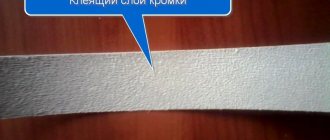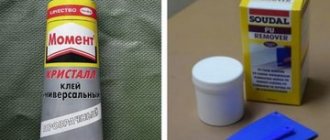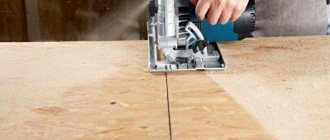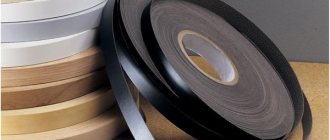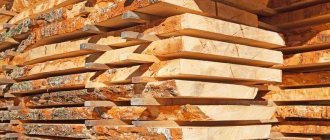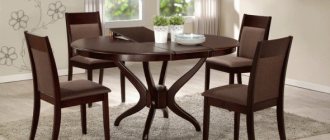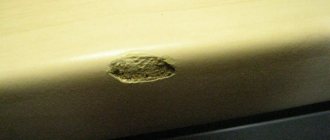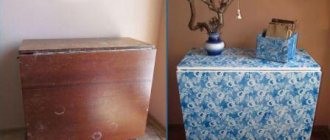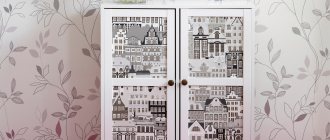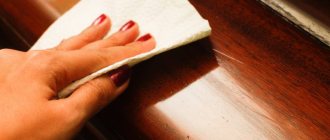The edge is used to protect the end edges of chipboard or MDF from impacts and abrasions, and from moisture. This treatment gives the edges of the furniture strength and protects others from the effects of formaldehyde, which impregnates the chipboard sheet inside. So let's figure out how to choose adhesive for PVC or chipboard edges.
Choosing glue for PVC edges
Kinds
There are such types of edges:
- Made from melamine - it is a tape made on a paper base with glue. It is usually used for finishing the interior parts of furniture. A budget-friendly, but not high-quality type of edge. It wears out quickly, is afraid of a damp environment and after some time can come off on its own. The only advantage of this finish is that the sticker does not require much time and can be done at home using a regular iron;
Types of edge covering
- The flexible T-shaped profile is a flexible T-shaped strip that is easily inserted into a pre-prepared cut in the side of chipboard or MDF. To install a mortise T profile at the end of the slab, it is necessary to mill a groove. If the profile becomes damaged over time, it can be easily replaced without disassembling the furniture. Of course, the use of this method is limited only by the availability of a milling machine;
- PVC edging - it gives furniture parts durability, increased wear resistance and protects the edges of the furniture from damage. But in order to stick it on, you need a machine for processing the edges, because of this, its use is limited;
- Made from ABS plastic - a more environmentally friendly analogue of the previous type. Made from plastic that does not contain chlorine. It is successfully used in the furniture industry due to its qualities such as impact resistance and heat resistance.
Profiles for processing furniture edges
You can trim the edge of furniture not only with edge tape. There are also furniture profiles that are attached mechanically. They are available in two sections - T-shaped or U-shaped (also called C-shaped).
For T-shaped furniture profiles, a groove is milled in the edge being processed. The profile is hammered into it with a furniture (rubber) mallet. The edges are cut at 45° to make the angle look attractive. It is brought to perfect condition with fine sandpaper. This type of profiles is produced from PVC and aluminum; with the same installation method, they look very different, and the differences are significant.
T-shaped furniture profile for processing furniture edges
In width they are available for laminated chipboards of 16 mm and 18 mm. There are also wide ones, but they are much less common, since they work less with such material.
C- or U-shaped profiles are most often mounted with glue. They coat the edge with it, then put on a plastic profile, press it well and fix it. These PVC profiles are soft and hard. Hard ones are harder to bend and it’s difficult to paste them over curved edges. But they have great strength.
Gluing C-shaped furniture profiles does not cause problems
If you still need to “fit” a rigid C-shaped furniture profile onto a bend, it is heated with a hair dryer, then given the desired shape and secured with masking tape until the glue dries.
Pasting process
If you want to save money, then use a melamine edge with glue, which is applied to the end of the product and simply ironed with a hot iron, after which the protruding parts are cut off with a knife. This method can also extend the life of old furniture.
Let's take a closer look at the simplest method. A hair dryer is suitable for this. But if you don’t have one, an iron will do. You will also need: a knife, a piece of cloth, fine sandpaper. So:
- It is necessary to cut off a piece of the edge, not forgetting about a margin of a couple of centimeters;
- Then place the melamine tape with the adhesive side on the piece;
- Apply a hot iron and wait until everything is thoroughly warmed up and the glue applied to the edge melts. For warming up, it is better to choose areas up to about half a meter;
- Using a rag, immediately after warming up, press the edge tape tightly. You can do this as soon as you remove the iron, as the glue quickly cools and hardens.
How to glue an edge to a tabletop
For optimal cladding, it is important that the table top is sawn off with high quality. Any glued edge holds better on a flat surface, and cut defects can only be hidden by an applied edge. It is also used specifically for tabletops, as it prevents objects from sliding off the table.
To glue the edge strip to the tabletop, it is necessary to properly prepare the work site so that the adhesion is as tight as possible and the strip does not move during the polymerization process.
Previous entry Furniture edge for chipboard. Varieties: PVC, ABS, 3d, melamine, U-shaped, etc.
Next entry Types of kitchen facades
Trimming excess
After gluing, it is necessary to trim off the excess to give the product a finished look. First of all, you need to trim the ends. When trimming off the excess, be careful not to accidentally damage the corners of the piece. Point the knife inside the part. For a high-quality result, you need to take a new knife with a sharp blade.
To complete the finishing process, go over the corners with sandpaper. They should turn out smooth, with a uniform chamfer, and when you hold them with your hand you should not feel any roughness.
You can also use an iron to remove the old edge tape. Heat the edge and remove it with a knife or sharp spatula.
Difference from profiles
Finishing profile
Confusion often arises with the concept of edge and finishing profile. You can disguise the end of the furniture with both, but the products are strikingly different from each other.
Profiles are made of PVC, wood, aluminum of different hardness. They are sold with a section in the letters T and C (aka P), and are slightly moldable. The edges are produced smooth, straight, and much more flexible.
The most important difference is the installation method. The edges are always glued with glue. Profiles are inserted into a milling groove (T form) or put on with a hook at the bottom and top of the end (C form). To shrink the profiles, they are “nailed” on top with a rubber mallet. Sometimes they are additionally glued or fixed with finishing nails.
The end for the profiles must be processed as carefully as possible - the edges are trimmed, the surface is sanded. Otherwise it will not sit correctly. There is no such problem with edges.
Hot melt adhesive
Hot melt adhesives have long taken a strong place in professional furniture production. Therefore, if you are going to put production on stream, it is better to switch to this type of adhesives and the corresponding equipment, which provides a fairly high speed of execution and more stable quality.
According to their physical properties, hot melt adhesives are classified as thermoplastics. This means that when they are heated, they become highly elastic and quickly turn to a solid state when cooled. High fluidity and strength when hardening are given to this type of adhesive by the presence of ethylene vinyl acetate polymer (EVA) in their composition. They also have excellent compatibility with different types of materials.
It is necessary for specialists who manufacture furniture at a professional level to know the properties and technological features of using these adhesives. The main disadvantage of their use is that you need to have the appropriate equipment for the job. The application and heating of hot melt adhesives to parts that need to be glued is done using hand guns or special machines.
Edge functions
When cutting parts from laminated chipboard panels, unsightly edges inevitably remain. This is due to the peculiarity of the material, its pressed structure. To disguise the cuts, a special tape is glued to the visible ribs, which
called furniture edge.
In addition to camouflage, it performs the following functions:
- protects the ends from drying out;
- prevents moisture from entering the fabric;
- blocks the penetration of dirt into pores;
- allows you to stylize and decorate an item;
- increases shock absorption during physical impact;
- corrects, hides defects and irregularities.
All of the above is especially true for cabinets, tables, and kitchen units.
Information about IKEA
Usually, when evaluating an item, including furniture, we approach it from the perspective of its further use.
However, there is one more aspect that cannot be ignored, especially when choosing furniture and especially a kitchen. Almost all modern kitchens are delivered disassembled and assembled on site. IKEA is no exception; it also sells its kitchens disassembled in neat cardboard boxes. There is even a whole line of business for assembling kitchens. Typically, the price of assembly depends on the cost and is about 10 percent of the price of the kitchen. For some reason, until now I have never seen end strips for countertops. When a tabletop is torn, for example, to install an electric stove, IKEA for some reason suggests installing connecting strips at the ends of the tabletop. Another thing I don't understand is the Ikea edging for countertops. For some reason it is thinner than necessary and it is not self-adhesive. Let's say we took a wonderful IKEA countertop and sawed it off with a jigsaw to the length we needed. The entire perimeter of the table top is covered with a 4 mm thick ABS edge, and the edge provided by IKEA is 2 mm thick. Agree that it is somehow strange when one end of the tabletop is different from the other.
Another disadvantage of IKEA furniture is that almost all IKEA furniture is “tightly” attached to the walls. If, for example, we are talking about assembling a cabinet, then after assembling and installing it in place you will not be able to move it even slightly, not to mention the fact that in order to fix the cabinet to the wall you will have to cut down either the baseboard under the cabinet, or vice versa, cabinet under the baseboard.
We would like to add that the above opinion reflects the position of one person and is subjective.
Source
Edge adhesive: types and characteristics
Special glue for PVC edges is produced mainly in the form of granules. Solid compositions are melted before use. At high temperatures, parts are quickly fixed. Drying takes minimal time. Granular adhesives contain:
- polymer binders;
- stabilizers, which are responsible for the immutability of structures under the influence of various negative factors;
- resins that increase bond strength;
- waxes that provide rapid hardening.
Solid glue turns into a paste or liquid substance under the influence of high temperatures. Before gluing structural elements, it must be applied in a thin, uniform layer over the surface. Next, it is enough to connect the parts and fix them in a motionless state until they completely harden.
Important! During the gluing process, it is necessary to strictly follow the manufacturer's recommendations regarding the thickness of the adhesive mixture. An insufficient amount of it will not provide the required strength. If there is an excess, the surfaces will be stained. Compositions with thermal pastes have the best properties. They dry in 1 to 5 minutes. Such adhesive mixtures are able to withstand the negative effects of moisture for a long time without losing their original characteristics. You can work with them when connecting relief parts, as well as elements that have a porous structure. Manufacturers produce several types of adhesives. They are selected according to the type of product, the conditions of their upcoming operation, and the loads.
When buying adhesive for the edge of a tabletop, you should pay attention to a contact material based on natural rubber. It demonstrates excellent performance when gluing not only wood boards, but also plastic, aluminum, PVC, leather, plywood, etc.
No matter how careful the craftsman is, in the process of gluing segments it is almost impossible to avoid getting glue on tools, equipment, and product surfaces. You can get rid of excess adhesives using a professional cleaner.
Having answered the question “why?”, let’s now figure out “where” and “how”
Therefore, firstly, there is no need to install the taps directly on the table, and secondly, you should not skimp on silicone when processing cuts under the sink. Haste in processing the ends and edges of the tabletop will also play a bad role. It is advisable to coat all cuts twice, each time allowing the sealant to dry.
But when installing the hob, you should not overuse silicone glue. The sawdust for cooking, of course, needs to be processed and dried. But you shouldn’t seal the joint with the table with silicone. A standard seal is sufficient for this.
As for the rear and side ends of the tabletop or possible joints of the canvases, they are also insulated using sealing materials. Side sections that are not adjacent to the walls are decorated with metal or plastic strips. If the tabletop canvas is made using softforming technology, then after treating the edge of the tabletop with sealant, an edge tape is attached to it.
All processes associated with the processing of chipboard countertops are carried out by our craftsmen without fail in what is called “autopilot” mode. While the insulated sections are drying, they solve more complex problems of competent and durable installation of the work surface: its tight fit to the walls and corners, fastening with brackets to floor cabinets... The entire algorithm is thought out to the smallest detail. That is why the company carries out all installation work within one working day, carefully, with guaranteed quality. Contact us! We'll be happy to help.
In furniture production, edging is necessary to protect the end edges of the product from chips, cracks and other damage, and it also protects against moisture and formaldehyde vapors.
You will learn about what types of edges there are, as well as methods for gluing them and how to glue the edges with an iron and hairdryer from this article.
